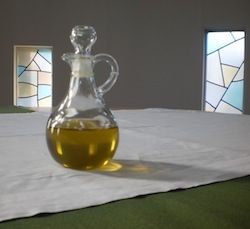Healing And Anointing

Living God, through the laying on of hands and anointing, grant comfort in suffering to all who are in need of healing. When they are afraid, give them courage; when afflicted, give them patience; when dejected, give them hope; and when alone, assure them of the support of your holy people…
- Rite of Healing, Evangelical Lutheran Worship
The sacramental rites of Healing and Anointing, which have been part of the church's ministry since its earliest days (see James 5:14-16) are a way to surround those in need of physical, emotional, or spiritual healing with our love, prayers, and a visible sign of God's presence symbolized by the holy oil.
While in the past it tended to be reserved for desperate situations and earned the nickname “Last Rites,” you most certainly do not need to be at death’s door or even physically ill to receive Healing. It is not a kind of spiritual magic, nor is it meant to take the place of the healing ministry provided by doctors and nurses. Rather, it is a powerful and tangible sign of God's presence and love—and the support of this community of faith—in the midst of whatever hurts us.
We all come with different needs, but it is the same God who touches us through the laying on of hands and anointing. When we come forward to receive healing, we are returning to our place in God’s loving arms, where we were set free from every bondage and fear. Knowing that we have a God whose love is stronger than every disease is the truest form of healing there is.
The rites of Healing and Anointing are offered at least once during the seasons of Advent and Lent during midweek worship services, and on a Sunday near St. Luke the Physician's Day (Oct. 18) but is always available privately with the Pastor.